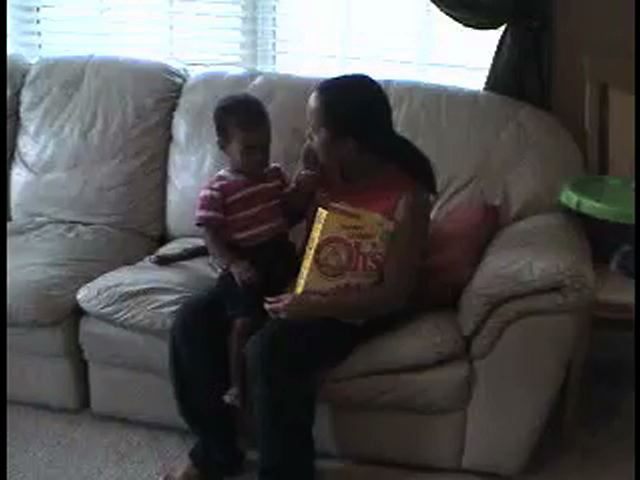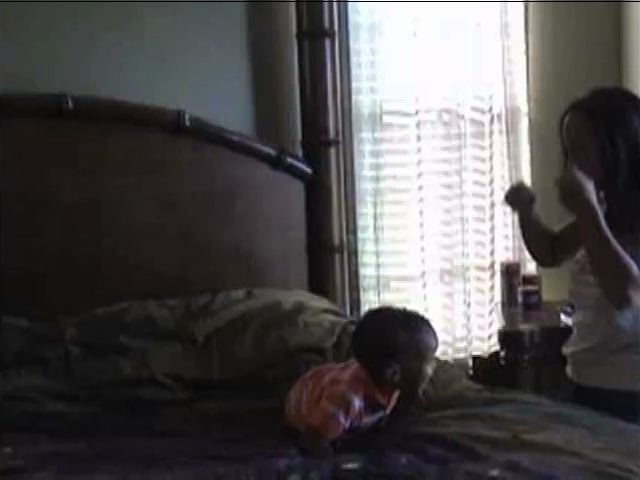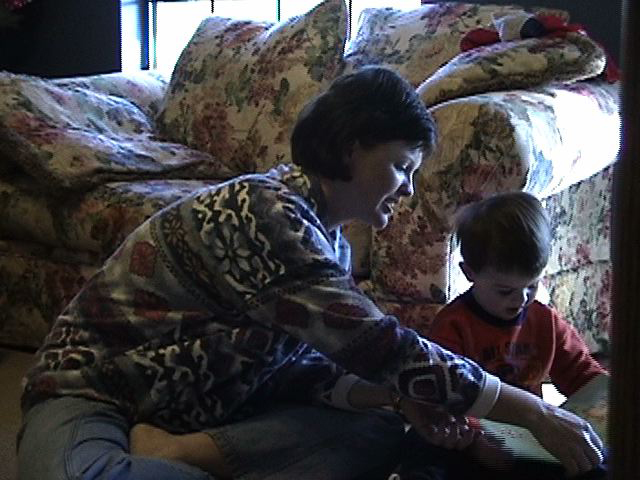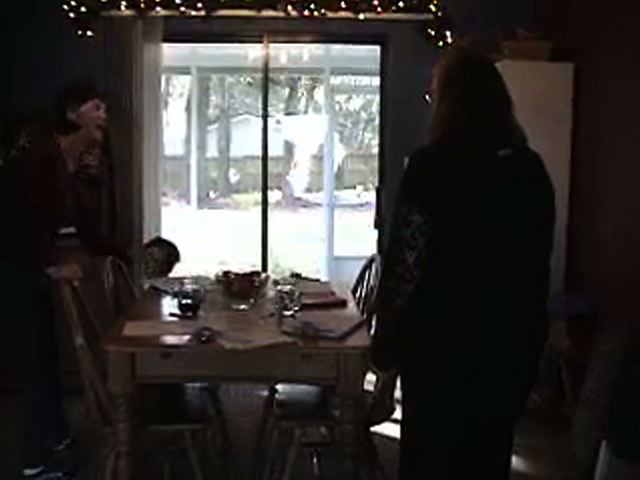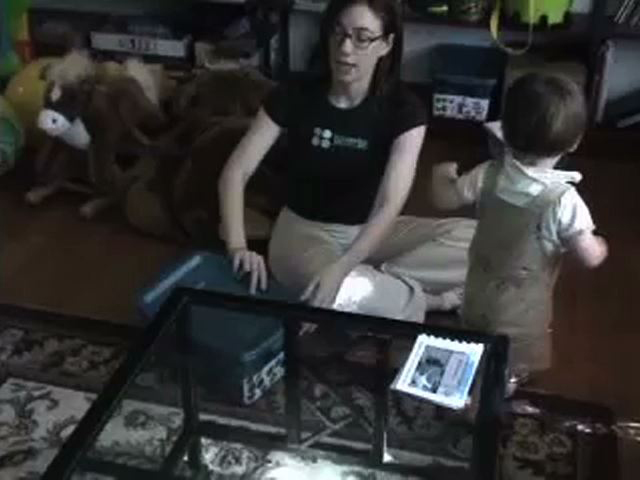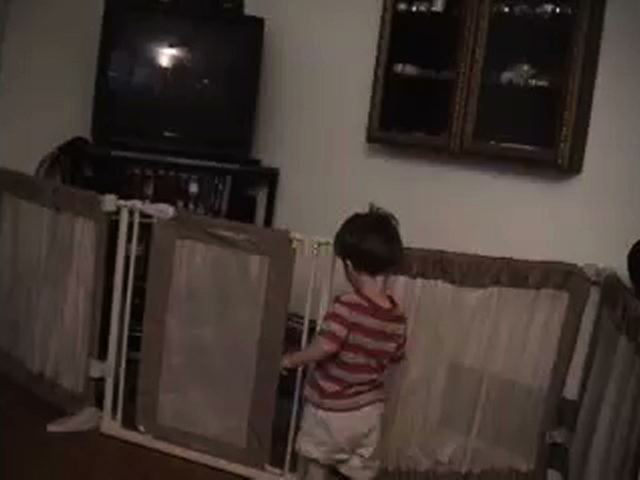
Video Clips Illustrating ESI with 3 Families
Jalen, 20 months
This clip takes place during a home assessment before beginning ESI treatment. As Mom offers a snack to Jalen, she takes turns talking to him, but he gets frustrated when he is not sure how to communicate that he wants more cereal. This activity does not establish a clear and predictable routine. Then, Jalen entertains himself by wobbling a plate. He squeals when the plate is out of reach and shows his interest and persistence in wobbling. Jalen gets excited, jumping and flapping his arms, a behavior common in young children with ASD. Next, the interventionist coaches Mom while including Jalen in doing laundry. Mom moves clothes from dryer to basket and then encourages Jalen to take a turn. When he does not understand his role, Mom prompts him with the word "in" and repeated modeling, and soon he takes a turn all by himself. Lastly, Mom starts an exchange with a rolling musical toy. Jalen uses a whining sound to ask Mom to help push the toy. Mom allows Jalen to use her hand as a tool in conjunction with his sound. Mom also offers support for Jalen to remain calm when he is upset by the clinician taking a turn with the toy. Now, everyone is on the same page during the activity.
This next clip shows Jalen later at 20 months. See how Mom supports her son's progress. Mom establishes a new routine as she tosses him gently on the bed. Notice all of the fun opportunities for communicating and sharing. Mom holds Jalen close. She says “ready,” then counts and waits until he looks at her, and then she tosses him. Next, Mom and son prepare for bath time. Mom sets up a predictable sequence of events with roles for her son, such as closing the door, getting a washcloth, and turning on the water. She uses frequent praise and simple, exaggerated language to keep him involved. Notice how often Jalen now looks to Mom to share his excitement. When Jalen unplugs the tub, Mom uses simple language with exaggerated intonation like "Ooopen, shut them!” to create anticipation and motivation. She follows his interest when he points to his reflection, another opportunity for joint attention and shared joy. During a snack, Mom provides a model, imitates his gestures, and waits expectantly for her son to make a request. She gives clear instructions and holds him firmly but gently to each one. This activity features great active engagement and a nice balance of turns. Look how much both Mom and her son are learning.
Caleb, 21 months
This clip shows Mom sharing a book with her 21-month-old son with ASD. In the previous month, Mom has been learning ESI strategies. Mom is well-positioned on the floor next to Caleb. She reads a book, leaving spaces for him to take turns. She follows Caleb's focus of attention. While he looks on, she describes the pictures or asks him to point. Mom pauses with the expectation for Caleb to chime in and turn the page. He looks at Mom and shares in the fun. Next, the interventionist helps Mom make a smooth transition from playing with Bear to another activity. The interventionist highlights the signals that Caleb is done with Bear, models "clean up" for Mom, and explains what she can do to keep him engaged. Mom does a good job of keeping him on track to put toys away. Later, the interventionist coaches Mom during Ring-Around-the-Rosie. The interventionist models and explains first and then guides Mom during the activity. ESI builds independence for parents so they have supports and strategies when the interventionist is not there.
This video shows Caleb at 22 months. First, Mom and interventionist discuss how to offer choices, and they model the names of food so Caleb can learn to make specific requests. Next, Mom offers a choice of two different characters to play with. When he protests, Mom responds by allowing her son to choose other toys (play food) but holds him to playing with the owl. Mom does a great job modeling language and play to keep him motivated. Later while playing with Play-Doh, Caleb spontaneously requests “bubbles.” Mom acknowledges his request but negotiates that first they need to make a star with the Play-Doh. He then requests the swing (outside) and comments that he needs his jacket. The interventionist shows Mom how to use a “first-then” picture to help with transitions from one activity to the next. The schedule (first star, then swing) affirms that they will go outside after they finish making the star, which helps Caleb focus on the activity at hand.
Iassac, 20 months
This clip shows Isaac at 20 months with ASD. He requests to play peek-a-boo by giving a blanket to his Mom. For one month, Mom has been learning ESI strategies and supports. Mom responds to his initiation, and then quickly makes the routine predictable and the language consistent. She does a nice job supporting his participation and use of gestures and sounds. Next during a "horsey ride," Mom sings a favorite verse from a nursery rhyme, which adds a predictable sequence of words to the routine. Mom expects Isaac to communicate and continue the routine, either through sounds, gestures, or sign language. She models first, then jumps in to help with certain words of the song. This creates shared joy, shifts in gaze, and more active roles for Isaac. Lastly, Mom uses ESI supports during book sharing. She positions herself properly for face-to-face interaction and encourages Isaac to take turns by touching a picture, vocalizing, and turning the page. The interventionist provides specific feedback for Mom, and they work together to make more opportunities for cooperation and connection for Isaac.
The second video shows the same child 22 months. Mom offers choices, then sets up a ball activity with clear roles and predictable steps. Mom waits patiently for Isaac to practice saying his version of “ready, set, go.” Next, see how reading books has developed in two months of treatment. The predictable nature of this book, Brown Bear, offers the structure this child needs. Notice how Mom pauses in key places in the book and is now able to hold out for more sophisticated communication such as gesturing and even imitating key sounds and words in the book. Shared joy and shifts in gaze still continue even though Mom now expects better communication from Isaac.
